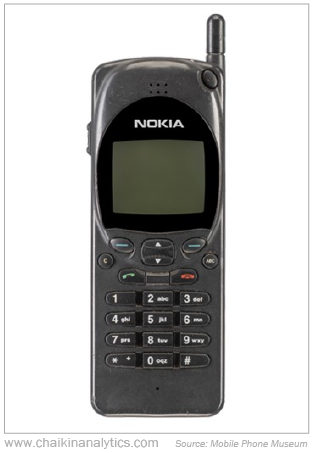In 1994, everyone was talking about the “2110.”
It was the model of a brand-new mobile phone from Finnish tech company Nokia.
But it wasn’t just any run-of-the-mill mobile phone…
The 2110 was the first of its kind to introduce short-messaging-service (“SMS”) features that made it easy for anyone to send texts over to another person with a similar device.
Even better, it let folks get a message to someone else without having to pay otherwise expensive voice-call rates.
And compared with the usual big, clunky handsets with thick batteries at the time, the 2110 was stylish. Here’s what it looked like…
It was an “aha moment” for Nokia that helped revolutionize the telecommunications industry. Texting was a huge hit.
And Nokia went on to develop even better-looking mobile phones that did the same things.
They became smaller, too. One called the 8850 was barely 4 inches tall and weighed a little more than 3 ounces.
In the late 1990s, Nokia seemed unstoppable. At one point, it was Europe’s largest company.
Today, texting is still one of the most popular forms of electronic communication. But hardly anyone you or I know still carries a Nokia phone.
They’ve been replaced mostly by smartphones. And in particular, iPhones by tech giant Apple (AAPL).
You see, folks, Apple’s “aha moment” as a mobile-phone company came when it introduced the first iPhone back in 2007…
It was the first mobile phone with multitouch technology. That means allowing two or more points of contact with the screen to become recognizable.
It also had a built-in music player, a high-definition digital camera, and an Internet browser. Take a look at it…
People with an iPhone could do everything they did with their Nokia phones. But they could also use it as a camera, music player, or like a miniature computer to look at websites and send e-mails.
The first iPhone ushered in the age of smartphones.
And Apple went on to dominate the market for these devices. It also introduced bigger, faster, and brighter smartphones over the years.
But as a company focused on developing technology for the consumer, it’s important – even vital – to always come up with that “aha moment.”
It’s something that totally revolutionizes the way people do things. It changes behavior.
But that hasn’t happened at Apple for a while. The latest iPhone – the iPhone 15 – hasn’t significantly changed the way the first iPhone impacted people’s lives.
It’s just mostly a lot faster, has a bigger screen and storage, and costs far more than what the original iPhone was selling for nearly 17 years ago.
Every quarter, the pressure is building for Apple to come up with a new “aha moment.”
Some folks say it could be the company’s “Vision Pro” headset. But at more than $3,000, it’s unlikely to hit mainstream. In fact, back in February, we discussed some of the issues for this to move the needle at Apple.
Others say it’s electric vehicles (“EVs”). But Apple recently shut down its “Project Titan” EV program after disappointing market performance.
That’s not to say that Apple’s days are numbered…
The company has built up a massive ecosystem. It has bridged digital devices with an easy-to-use operating system.
Then, earlier this month, Apple announced a record share-buyback program. It plans to buy back a whopping $110 billion in stock.
And Apple can afford to do it. At the end of last year, Apple boasted free cash flow of about $100 billion and about $60 billion in cash.
But Apple is ultimately driven by innovation. And it must find a way to use all the money it generates to launch new products that keep it growing.
Only time will tell whether Apple will be able to introduce another revolutionary product that does what the Nokia 2110 and the first iPhone model did.
But the Power Gauge is still “neutral” on Apple – like it was when we discussed the company back in February.
So, for now, I’m still waiting on another “aha moment” from Apple. And I’m waiting on a stronger signal from the Power Gauge for the company’s stock.
Good investing,
Vic Lederman

